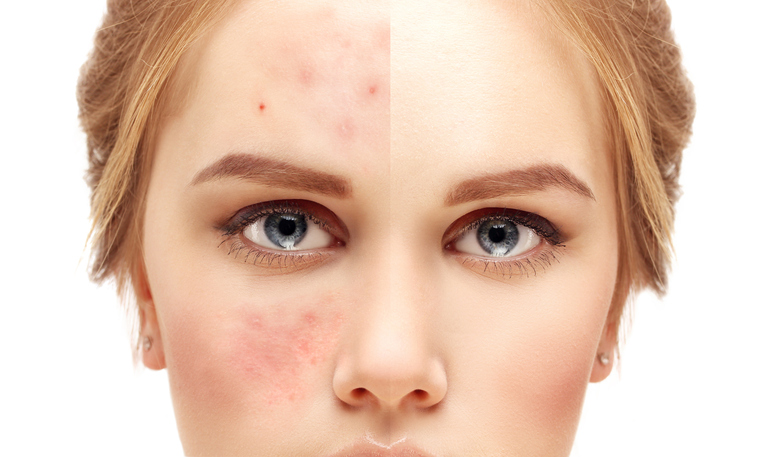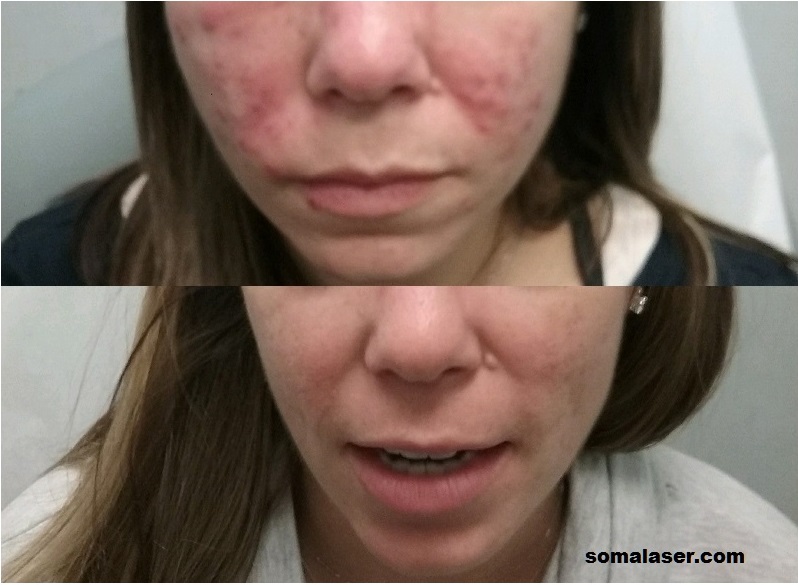Acne Treatments
Call For Your Acne Consultation Today
Call: 973-763-7546

Acne Treatments – ** Image does not indicate results from any specific procedure
Treatment of your acne at SOMA Skin & Laser begins with an evaluation by a board-certified dermatologist. There are a number of treatment approaches that are employed depending on acne severity and other factors.
Topical Agents for Acne
The first-line of acne therapy is usually topical treatments, especially topical antibiotics and topical retinoids. There are numerous brand names, but the common agents are: benzoyl peroxide, retinoids (e.g. tretinoin (Retin-a), adapalene ( Differin), tazarotene (Tazorac), trifarotene (Aklief)), and clindamycin. There are combination products, such as Veltin, Epiduo, and Ziana that combine a retinoid with an antibiotic or benzoyl peroxide, as well as products such as Duac, Benzaclin, and Onexton that combine an antibiotic and benzoyl peroxide. These combination acne products make compliance easier. Many topical agents can cause dryness, especially benzoyl peroxide and retinoids. A non-comedogenic moisturizer can be used to counteract any dryness or peeling. Topical agents can also be used every other day or alternated to decrease irritation. Benzoyl peroxide washes, such as the SOMA Skin & Laser benzoyl peroxide wash, can be used for short-contact times (5-10 seconds) to reduce dryness and irritation.
Systemic antibiotics for acne
Systemic antibiotics are often added to the regimen for more resistant acne. Doxycycline or minocycline is usually the first line agents employed, though erythromycin, Bactrim, Keflex and other antibiotics may have roles as well. A newer tetracycline antibiotic, sarecycline (Seysara) is now available as well. However, it is also possible to treat acne without using antibiotics.
Systemic retinoids for acne
Oral isotretinoin, previously known by the widely-used brand name Accutane, is used for patients with severe acne that does not respond to other measures. Side effect include chapped lips and dry skin, but more serious systemic side-effects may occur, such as elevation in liver enzymes and abnormalities of lipid metabolism. Most significantly, isotretinoin is teratogenic (causes birth defects) and cannot be used in pregnant women or in women that might become pregnant. Birth control measures and rigorous monitoring are necessary to ensure compliance. Patients must be registered in a special monitoring program called iPledge, administered by the drug’s manufacturers. The risks and benefits must be discussed fully with an experienced dermatologist. Isotretinoin is used for several months, usually at least five. However, the longer the course of treatment and the greater the total amount of isotretinoin taken, the better the chance of remaining acne-free after the course of treatment.

Acne Before & After 7 months of Isotretinoin (results may vary patient to patient)
Oral contraceptive pills (OCP) and anti-androgens for acne
OCPs and antiandrogens are beneficial in some patients with acne, particularly those with hormonal or peri-menstrual flares. Spironolactone, a blood pressure medication, is frequently used off label to treat hormonal acne in women.
Acne surgery and intralesional injections
Acne surgery, extracting resistant comedones (whiteheads and blackheads), and injecting cysts and stubborn lesions with dilute steroid is an important part of acne treatment provided by your dermatologist. This is ideal for the occasional inflammatory papule, often shrinking the breakout in 1-2 days.
Lasers and light for acne
Certain lasers and light sources have been shown to be beneficial in the treatment of acne, sometimes in combination with a photosensitizer, such as Levulan. Blue light alone, termed BLU-U, can also be used to reduce acne when used regularly. Lasers can also reduce the appearance of acne scarring. The Vbeam laser is often used to reduce redness, while the DEKA CO2 fractional ablative laser is used to treat pock-marks and atrophic acne scars. The q-switched Nd:YAG laser can be used to treat hyperpigmentation. The q-switched Nd:YAG laser is also used to remove blackheads. Consistent use with the q-switched Nd:YAG laser may also reduce the amount of the p. acnes bacteria, reduce sebum production, and improve the appearance of pores.
Chemical peels for acne
Chemical peels are often helpful for treating both acne as well as the hyperpigmentation and scarring that can sometimes result from acne lesions. Salicylic acid and glycolic acid peels are commonly used.
Treatment of acne scarring
Treatment of acne scars and marks is achieved with a number of modalities. Chemical peels, microdermabrasion, the Vbeam laser and the DEKA SmartXide DOT laser are all used depending on the type of acne mark to be treated. Microneedling and growth factors is another possible treatment. Bleaching creams are also sometimes required to treat dark marks from acne, which is common on darker skin types.
At SOMA Skin & Laser, your dermatologist will work to devise an acne treatment plan that is right for you.
More Acne Information at SOMA Skin & Laser Blog

